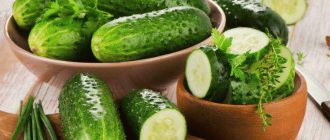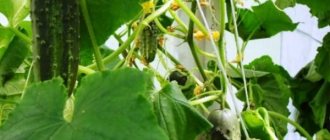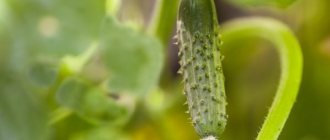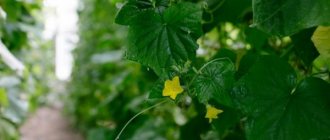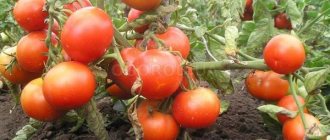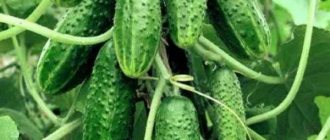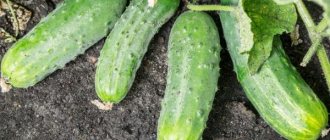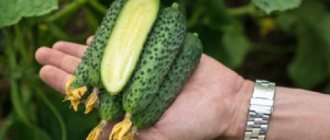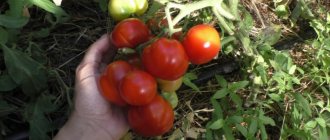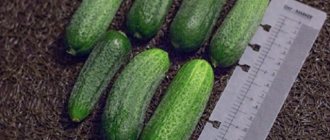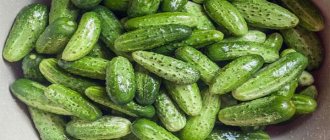Author: Natalya Category: Garden plants Published: February 26, 2019Last edits: January 6, 2021
- Varieties of cucumbers for pickling
At the end of winter, seeds of all crops grown in the garden appear for sale in garden pavilions, shops and markets, among which cucumbers occupy one of the most honorable places. The number of varieties offered can baffle even experienced gardeners.
Characteristics of cucumber varieties
To determine which varieties to prefer, you need to correctly set your priorities, and for this you need to understand what varieties generally exist in the culture. Without going into the professional subtleties on which the classification of cucumber varieties is based, we will try to introduce you to the most important characteristics of these vegetables. So, varieties of cucumbers are divided into the following categories:
- growing region: for each region there are zoned varieties that cope better than others with weather conditions and diseases and pests common in a certain area;
- planting location: there are varieties of cucumbers for open ground and for protected ground - greenhouses, hotbeds and for growing on a windowsill or balcony;
- ripening speed: according to this criterion, varieties are divided into early, middle (mid-ripening) and late, as well as intermediate - mid-early and mid-late;
- type of pollination: from this point of view, varieties are parthenocarpic, that is, not requiring pollination at all, bee-pollinated and self-pollinated;
- purpose: there are cucumbers suitable only for fresh consumption, there are those intended for processing, that is, for pickling or pickling, and there are universal varieties, consumed both fresh and processed;
- crop selection: varieties and hybrids of cucumbers are distinguished. The advantages of the varieties are that they retain their distinctive qualities in several generations and are suitable for processing, but the disadvantages can be considered a small number of ovaries, too large fruits that quickly turn yellow and outgrow. The advantages of hybrids (F1) are small fruits, several ovaries in one bosom (arranged in a bunch), early fruiting, bright coloring, and in addition, the hybrid greens retain their good appearance for a long time and do not turn yellow. The disadvantages of hybrid cucumbers are the higher cost of seeds and the preservation of the properties of the variety in only one generation;
- type of flowering: it can be mixed, female or predominantly female;
- fruit size: according to this criterion, cucumbers are divided into gherkins, whose greens are no more than 8 cm long, and salad cucumbers, whose length reaches 20-25 cm or more;
- fruit color: the vast majority of cucumbers have a green fruit color, but there are varieties of white cucumbers, and they differ from green ones only in color and a complete lack of bitterness. There are also red cucumbers, but in our gardens they grow like weeds;
- the nature of the surface of the greens: cucumbers are large-tubercular and small-tubercular, and the spines on them are white or black. There are also thornless varieties of cucumbers;
- growing method: bush, short-climbing (usually a sign of early varieties), medium-climbing, which is more typical of mid-ripening varieties, and long-climbing - represented, as a rule, by late varieties. There are varieties with the so-called bunched ovary formation, in which up to 7 cucumbers can form in one axil. The method of growing cucumbers also depends on the formation of pinching of the bush;
- productivity: there are less, more and very productive varieties of cucumbers;
- resistance to diseases and pests: this is a very important characteristic. You should know that the earlier cucumbers ripen, the lower their resistance to diseases, that is, in early cucumbers it will definitely be lower than in late varieties.
Varieties of cucumbers for greenhouses - early, late and best
Varieties of cucumbers for open ground
Early varieties of cucumbers
Early varieties are considered to be those in which 32 to 44 days pass from the moment of germination to the first harvest of greens. Well-known early varieties include:
- Masha is the earliest universal parthenocarpic hybrid variety, resistant to cladosporiosis, viral mosaic and powdery mildew. Zelentsy of this variety reach a length of 8 to 11 cm;
- Rodnichok is a bee-pollinated pickling variety with bitter-free fruits weighing up to 120 g;
- Connie is a disease-resistant, productive parthenocarpic hybrid variety of universal use with white-thorned cylindrical greens that are devoid of bitterness;
- Champion is also a productive hybrid parthenocarpic variety, resistant to diseases, with large tuberculate fruits intended for processing;
- Herman is one of the most popular universal parthenocarpic hybrids, resistant to cladosporiosis and downy mildew and is a vigorous plant with dark green white-thorned cylindrical large-tubercular fruits up to 12 cm long.
In addition to those described, early varieties and hybrids include Kurazh, New Nezhinsky, Kustovoy, Vyaznikovsky 37, Konkurent, Miranda, Ira, Emerald Potok, Delicatesny, Corinna, Gherkin Madame, Alligator, Karelsky and others.
- When to plant carrots before winter in October 2021
Medium varieties of cucumbers
Mid-season cucumber varieties include those that ripen in 45 to 50 days. The most popular of them include:
- Nezhinsky 12 is one of the best pickling bee-pollinated varieties, characterized by its ease of care and resistance to bacteriosis and olive spot. Greens of this variety, short, black-thorned, with large tubercles, excellent taste, weighing from 80 to 110 g and 10-12 cm long, ripen on long-climbing bushes;
- Son of the Regiment is a universal bee-pollinated hybrid, resistant to mosaic, scab and powdery mildew. This is a medium-branched and medium-sized plant with a predominantly female type of flowering. The cucumbers are oval, white-thorned, large and sparsely tuberous, up to 8 cm long, with short light stripes, do not turn yellow for a long time and do not outgrow. They are collected for canning pickles and gherkins. The variety has high taste and the ability to bear fruit for a long time;
- Far Eastern 27 is a medium-branched, productive and drought-resistant pickling variety for universal use with elongated light green with white stripes large-tubercular greens of excellent taste, 11-15 cm long, 4-5 cm in diameter and weighing 100-200 g. The cucumbers have thick black spines;
- Nezhinsky local is one of the best pickling varieties, bee-pollinated, resistant to the cucumber mosaic virus and olive blotch, highly branched and vigorous, with mixed flowering type. Coarsely tuberous, ovoid, with sparse black thorns, excellent-tasting greens reach a weight of 80-110 g and are used not only for canning, but also for salads;
- The new phoenix is a cold-resistant bee-pollinated variety that is resistant to powdery mildew, downy mildew and unfavorable weather conditions. Cucumbers are dark green with short blurry stripes.
In addition to those described, such mid-season varieties of cucumbers are known as Malysh, Pogrebok, Moth, Phoenix Plus, Sunny, Stepnoy, Levadny, White Delicacy, High-Yielding 86, Farmer, Nugget, Ruslan 95, Nerosimy 40 and hybrids Moravian Gherkin, Russian Style, Picas, White Angel, Raphael and others.
Late varieties of cucumbers
Late varieties of cucumbers take more than 50 days to ripen. Among the most famous late-ripening varieties:
- Chinese climbing plant is a medium-branched and long-climbing plant of mixed flowering type with cylindrical green leaves 10-12 cm long and weighing 100-130 g. Among the advantages of the variety are stable yield, resistance to downy mildew and low temperatures, high pickling quality;
- Chinese miracle is a universal-purpose variety, ripening in up to 70 days, with cylindrical, thin-skinned, sparsely tuberous and slightly curved greens up to 59 cm long;
- Khrust is a high-yielding hybrid variety for universal use, characterized by long-term fruiting and disease resistance. Greens of this variety, 8-10 cm long and weighing 60-80 g, have crispy, juicy flesh without bitterness and excellent taste;
- Nezhinsky is a bee-pollinated, productive pickling variety that is resistant to drought and disease and is characterized by long-term fruiting. Black-thorned greens of this variety, weighing 90-110 g and 9-13 cm long, have an excellent taste and aroma, but if they are left on the bush, they quickly outgrow;
- Relay is a bee-pollinated hybrid fruitful salad variety, which is grown in open ground only in warm regions. Greens of excellent taste with delicate glossy skin grow from 14 to 23 cm in length and weigh from 140 to 230 g.
The best varieties of cucumbers
Of the early ripening varieties, the best are considered to be Kustovoy, Altaiskiy ranniy, Vyaznikovskiy 37, Rodnichok, hybrids Masha, Lastochka, New Nezhinskiy, Konny, Champion, Courage and German.
Among the mid-season varieties - Adam, Director, Kibria, Chinese heat-resistant, Claudia, Mother-in-law, Barrel salting, Far Eastern 27, Phoenix plus, hybrids Amur, Libelle, Moravian gherkin, Russian style.
Among the late varieties, the good ones are Phoenix 640, Kapelka, Aquarius, Pobeditel, Donskoy 175, Brigadny, Vladivostoksky, Nezhinsky Local, Chinese Miracle, and the hybrid Relay.
What varieties and hybrids of cucumbers are most suitable for growing in the Non-Black Earth Zone?
Cucumber is grown in open ground, small shelters and greenhouses. For open ground and small-sized shelters, early and mid-ripening varieties Konkurent, Libelle, Buyan are used.
The most promising hybrids in spring greenhouses are: Buran, Rodnichok, Opal, Emerald, Zhuravlenok, Miranda, Severyanin, Izhorets, Saarsky, Natalie, German.
❖ The competitor is an early ripening variety with medium-sized fruits 9-12 cm long, weighing 70-100 g. It takes 42-48 days from germination to mass harvest. The variety is resistant to powdery mildew and bacteriosis,
after the vegetative mass dries out, powdery mildew quickly restores the growth of lateral shoots, and fruits form on them.
❖ Libelle is a bee-pollinated hybrid of mixed flowering type, does not require pollinating varieties. Suitable for open ground, film shelters and greenhouses. The fruits are finely tuberculate, with white spines, suitable for pickling and canning. Resistant to peronospora and bacteriosis.
❖ Buyan is a cluster-type hybrid, early ripening, from germination to the beginning of fruiting - 41-44 days. The plant has a female flowering type, is medium-sized, medium-climbing, and forms from two to four fruits in one node. The fruit is short, 8-10 cm long and 3.5-4.5 cm in diameter, cylindrical in shape, without a neck, coarsely tuberculate, without bitterness, light green in color with small longitudinal stripes and without spotting. Fruit weight 70-90 g. Suitable for canning, pickling and pickling. Plants have complex resistance to pathogens of major cucumber diseases.
❖ Altai is bee-pollinated, early, fruiting occurs 35-44 days after germination. The greenery is oval-shaped, large-tubercular, 9-13 cm long, weighing 90-100 g. Resistant to bacterial spotting. Suitable for pickling.
❖ Claudia is an early ripening parthenocarpic hybrid. Zelenets is cylindrical, medium-tubercular. Resistant to powdery mildew. Stable yield, high yield of marketable fruits. Suitable for pickling.
❖ Poplar is a mid-season hybrid, suitable for growing in greenhouses and open beds. Tolerates low temperatures well. The plant is powerful, double-climbing. Female flowers are predominantly on the side shoots; on the main shoot, fruiting begins from the sixth to ninth node. The fruit is oval-elongated, 12-14 cm long, cm in diameter, weighing 110-130 g, good taste both fresh and canned. From germination to fruiting - 50-58 days. The hybrid is resistant to olive spot, powdery mildew, and root rot.
❖ Buran is an early ripening hybrid, suitable for growing in greenhouses. It is distinguished by friendly fruiting. When grown, predominantly female flowers are produced, so it is necessary to plant several pollinating plants along with it. The fruits are very beautiful, cylindrical in shape, finely tuberculate, suitable for pickling and canning.
❖ Natalie is a bee-pollinated, early-ripening hybrid for film greenhouses. The plant is highly leafy, has a female flowering type, female flowers are on the main stem. The fruits are short, 11-13 cm, cylindrical in shape, no bitterness. Resistant to olive spot, bacteriosis, downy mildew. The value of the hybrid lies in its stable yield, resistance to adverse conditions, good taste, and suitability for processing.
❖ Opal is an early ripening hybrid, suitable for growing in greenhouses and in insulated soil. The fruits are medium-sized, 70-80 g, with a beautiful cylindrical shape. Suitable for pickling and canning. During the period of fruit formation on the main stem, lateral shoots develop much more slowly, which significantly reduces the time for pruning vines.
❖ German is an early-ripening hybrid of the female type, high-yielding, resistant to unfavorable factors, and requires increased nutrition during the fruiting period. The fruits are small, weighing 60-80 g, tuberculate, up to ten fruits are formed at a time. Recyclable.
❖ Chic is a predominantly female hybrid, early ripening, bearing fruit until late autumn. Zelentsy are medium-tubercular, 12-14 cm long, cylindrical in shape, with black spines. Up to three ovaries are formed in the nodes. The taste is high. Unsurpassed in salting and marinating. The hybrid is resistant to olive spot, powdery mildew and root rot.
❖ Vyatsky is an early ripening hybrid of the female type, vigorous, with a long and abundant harvest. The greens are tuberculate, white-spiked, cylindrical, 12-15 cm long, the weight of the greens is 120-130 g. The fruits are without bitterness, have high taste when fresh and are preserved in salting and pickling. The hybrid is resistant to temperature changes and adverse weather conditions, as well as to olive spot, downy mildew and root rot.
❖ Miranda - early ripening, high-yielding, predominantly female type. The plant is vigorous, well leafy, with 1-2 greens per node. The mass of greens is 110-120 g, the fruits are cylindrical in shape with white spines, juicy, aromatic, good both in salads and in any processing. They can be stored for 5-6 days without losing their presentation and are highly transportable. Miranda has increased cold resistance and resistance to powdery mildew. Talisman is a short-fruited parthenocarpic hybrid, mid-season, from germination to the beginning of fruiting - 50-55 days. The plant has a female flowering type, medium-climbing. The fruit is without bitterness, cylindrical, 10-12 cm long, sparsely tuberculate, fruit weight 80-100 g, suitable for canning. The hybrid is resistant to the pathogen of powdery mildew and tolerant to the pathogen of downy mildew.
❖ Northerner is an early ripening hybrid of a new type, characterized by weak shoot-forming ability. The harvest is formed on the main stem; three, sometimes four, fruits are formed at the nodes. The growth of fruits in a node does not occur simultaneously, but sequentially, that is, first the first fruit grows, then, when it is removed, the second fruit begins to grow, then the third fruit. Almost no plant formation required. Resistant to low temperatures and root rot. The value of the hybrid is its high resistance to adverse conditions. Recyclable.
❖ Izhorets is an early ripening hybrid with a weak shoot-forming ability and requires almost no formation. 2-3 ovaries are formed in the nodes. The fruits are cylindrical, 9-12 cm, suitable for processing. Resistant to adverse conditions.
❖ Saar - an early ripening hybrid, fruiting on the main stem, weak foliage and limited shoot-forming ability. 2-3 ovaries are formed in the nodes. The fruits are cylindrical, 8-11 cm, do not outgrow, and are suitable for processing.
What is a hybrid?
When crossing genetically different parental forms (different varieties), hybrids are obtained. The breeder selects parental pairs, crosses them and, based on the offspring, determines the economic suitability of the hybrid. Hybrids must have higher economic qualities; than the original parent forms. To obtain hybrid seeds, crossing is necessary each time. Hybrid seeds are obtained from seed breeding companies or by a breeder. The packet of hybrid seeds must have the “F1” icon on it.
What is a parthenocarpic variety and how does it differ from a bee-pollinated variety?
In bee-pollinated varieties, pollination occurs with the help of bees or other insects. Parthenocarpic varieties form fruits without pollination. And if a flower of a parthenocarpic variety is pollinated by an insect, then the fruit turns out to be ugly.
We recommend watching:
What are the structural features of a cucumber?
Growing cucumber seedlings
Which cucumber seeds to choose? The best varieties of cucumbers
What are the benefits of cucumber? Medicinal properties of cucumber
How to choose the right variety of cucumbers?
Self-pollinating cucumber varieties
Statistics say that gardeners prefer to grow self-pollinating varieties of cucumbers for open ground, since they, compared to parthenocarpic varieties, have a brighter taste and aroma, and besides, the early, most valuable cucumbers belong precisely to this type of pollination. Parthenocarpic varieties are often planted in greenhouses in which there are no insects that pollinate cucumber flowers, since these cucumbers do not need pollination for successful fruiting. However, the fruits of parthenocarpic cucumbers do not form seeds.
Growing cucumbers in a greenhouse - planting and care
Self-pollinating cucumbers are considered to be those whose flowers have both male and female reproductive organs - both pistil and stamens, so pollination occurs independently within one plant, and as a result, fruits with seeds are formed.
The best self-pollinating varieties can be considered the following:
- Gerda is a mid-early universal gherkin variety characterized by high germination and disease resistance. Its greens of excellent taste grow up to 10 cm in length;
- Friendly Family is also a mid-early, versatile, unpretentious and disease-resistant variety with dense greens up to 12 cm long, which do not have a bitter taste;
- White Angel is a universal, productive hybrid variety with white cucumbers 6-8 cm long and weighing 60-70 g. The tubercles are sparse, there is no bitterness;
- Zadavaka is a universal gherkin bunch hybrid with large-tuberous greens of a beautiful shape, dark green in color with blurred white stripes. The thorns are black, there is no bitterness in the taste. This variety bears fruit until frost;
- Spring is a universal, medium-branched variety, resistant to disease, with short green leaves of a sweetish taste.
As a rule, self-pollinating varieties of cucumbers, like parthenocarpic varieties, are grown in greenhouses, but not because they cannot grow and bear fruit in a garden bed under the sun, but because there are no pollinating insects in greenhouses. There are, of course, self-pollinating varieties exclusively for greenhouses, but for the most part these cucumbers grow just as successfully in open ground.
What are hybrid varieties of cucumbers?
Cucumber hybrids have been quite widespread among gardeners for a long time, and not everyone understands the advantages of growing them, and some are even wary. Let's figure it out together.
Hybrid varieties are created when two different types of cucumbers with desired traits are crossed, resulting in a new one. Sometimes such selection occurs over several generations.
Those whose seeds are sold in gardening stores receive improved qualities that make it possible to obtain harvests in unfavorable climatic conditions, for example, in the Urals or Siberia, or to harvest crops as early as June. There is nothing dangerous in such selection, but there are many advantages.
All varieties of cucumbers that are hybrid are marked on the pack with the designation F1. In our rating, each variety name also has the letter F1, which means “this is a hybrid.”
Advantages of hybrid varieties
When the question arises of what to choose - a specific variety of cucumber or a hybrid - choose the latter. Read below about which one, but in general they all have a number of advantages:
1) higher yield: most hybrids bear fruit longer and longer, compared to varieties
2) resistance to cucumber diseases makes hybrids more unpretentious to care for (primarily, we are talking about powdery mildew)
3) less bitterness: most of the bred varieties are not bitter - this has been tested and verified at the genetic level
4) earlier ripening: there are special hybrids that begin to produce crops in June. There is even a ripening record - 33 days (Arctic hybrid)
5) the ability to grow cucumbers without pollination: the so-called self-pollinating and parthenocarpic species can be grown in a greenhouse without the need for insects
Thus, hybrid varieties have many advantages in terms of ripening and yield.
Disadvantages of hybrid cucumbers
In fairness, it is worth noting two drawbacks.
Firstly, and this is the main thing, it is impossible to independently prepare seed material for next year. Hybrids are not designed for seed preparation, so they must be purchased anew each time.
Secondly, it is inconvenient for those gardeners who derive pleasure, and one might say scientific interest, from grafting plants and conducting their own experiments.
How to choose hybrid cucumber seeds?
If you are asking the question, “What varieties of hybrids should you choose?”, then you should proceed from your conditions and goals. They will be different for each gardener, so pay attention to the recommendations below.
1. Growing method - in a greenhouse or open ground
2. Geography - do you need frost-resistant varieties, are there any changes in climate
3. Timing of ripening - do you want to harvest early or late ripening crops?
4. Taste - what do you want to grow cucumbers for: pickling, canning or salads
Bunch varieties of cucumbers
Bundle cucumbers have one feature that distinguishes them from other varieties: they form several ovaries in one node, and their number depends on factors such as growing conditions (that is, the amount of sunlight received by the plant), growing location (greenhouse or open ground ) and the general condition of the plant. In recent years, bunch varieties have been rapidly gaining popularity, and the most famous of them are:
- Vyuga is a quickly ripening, high-yielding parthenocarpic hybrid with a female type of flowering, forming in one ovary up to 4-5 elliptical fruits of dark green color with yellow stripes, growing up to 8 cm in length and gaining a mass of 60-70 g. The surface of the greens is covered with large tubercles and brown pubescence;
- Detinets is an early ripening, highly productive parthenocarpic hybrid variety with a predominantly female flowering type, in all axils of which, except the first, up to five ovaries are formed. The cylindrical green fruits of Detinets with light yellow stripes reach a length of 10-12 cm, weigh 90-120 g and have an excellent taste. Their skin is covered with small tubercles and light brown spines;
- Boy-thumb is a productive and versatile parthenocarpic variety resistant to olive spot, powdery mildew and downy mildew, forming 3-6 ovaries in the axils. Greens of this variety, 8-10 cm long, bright green with white spines and large tubercles, have a good taste;
- Master is a hybrid parthenocarpic of the gherkin type with a female type of flowering, resistant to temperature fluctuations and forming up to 6 ovaries in one node. Dense elliptical fruits with crispy tasty pulp, no more than 12 cm long and weighing from 80 to 110 g, are covered with a dark green peel with white spines and frequent tubercles. No bitterness is felt either in the pulp or in the peel;
- Okhotny row is a universal hybrid parthenocarpic of the gherkin type with a female type of flowering, resistant to all diseases except powdery mildew, and forming from 2 to 6 ovaries in the axils. The cucumbers of this variety are cylindrical, tuberculate, white-spiked, 8-11 cm long, of excellent taste.
Such bunched cucumber varieties as Robin Hood, King of the Beds, hybrids Junior Lieutenant, Three Tankmen, Buyan, Chistye Prudy, Maryina Roshcha, Machaon, Labyrinth, Calendar and others have also proven themselves well.
Fast ripening varieties
Not all ultra-early ripening hybrids take root in open ground or are suitable for harvesting, and gardeners often plant cucumbers that are harvested a little later.
Nightingale
The variety of domestic origin feels normal in the garden under the hot rays of the sun. The fruits acquire a rich green color, ripen 49–50 days after sowing, have an oblong shape, and weigh 70 g.
Princess
An indeterminate hybrid produces a high yield in greenhouses; in open ground, plant productivity is reduced by 2 times. Short, tuberous Knyazhny cucumbers are decorated with long light stripes, covered in white thorns, and are good for pickling.
Martin
The description of the variety, the seeds of which appeared on the market several years ago, interested vegetable growers who love to experiment. From one bush, Swallows pick three dozen fruits with black thorns; the greens ripen in 35 days.
The most productive varieties of cucumbers
Productivity is a relative sign, since it depends not only on the variety, but also on other factors - weather conditions, soil composition, quality of care. However, there are varieties that even in less than ideal conditions produce good yields, and most often these are hybrids. The following high-yielding varieties of cucumbers are known in garden culture:
- Dill: growing on the windowsill and in the garden
- resident is an early-ripening hybrid variety of medium height and medium branching with a predominantly female type of flowering. It has green cylindrical fruits weighing up to 90 g. From one m² of plot you can get 13-14 kg of fruits;
- Dasha is a bee-pollinated hybrid, resistant to bacteriosis and powdery mildew, with dark green white-spined elongated cylindrical tuberculate greens up to 10 cm long and weighing up to 115 g;
- Krepysh is a bee-pollinated hybrid resistant to powdery mildew and peronosporosis with short tuberculate cucumbers weighing 70-100 g with white pubescence. From 1 m² of bed you can collect up to 12 kg of greens;
- Dvoryansky is a mid-early bee-pollinated hybrid with a predominantly female type of flowering, resistant to bacteriosis, anthracnose, ascochyta blight, viral infection and olive spot. Light green, finely tuberculated and white-thorned greens reach a length of 10-13 cm, and weigh 100-110 g. Up to 14 kg of fruits are collected from one m²;
- Pinocchio is a cold-resistant parthenocarpic hybrid with a predominantly female type of flowering and a bouquet (beam) arrangement of ovaries, of which up to 6 are formed in one axil. Dark green, elongated, cylindrical, large-lumpy greens, reaching a length of 8-9 cm and weighing about 100 g, are devoid of bitterness. The yield is up to 13 kg per 1 m² of area.
In addition to those described, such productive varieties of cucumbers for open ground are known as Suzanna, Altaisky early 166, Muromsky 36, Voronezhsky, Khrustishchiy, Izyashchny, Kustovoy, hybrids Sparta, Raznosol, Murashka, Rodnichok and others.
The best varieties of cucumbers for the central black earth region
The success of the cucumber harvest depends, in part, on the choice of seed material. The wide assortment on the shelves confuses thoughts more than allows you to make the right decision. Beginning gardeners are recommended to first familiarize themselves with the varieties, their names, cultivation and care features.
Depending on climatic conditions, different varieties can be planted in Ukraine, Belarus, the Black Earth Region, Bashkiria and the middle zone - these can be parthenocarpic, early ripening, with a long ripening period, or tasty cucumbers for growing in a greenhouse. More detailed information is structured in the article in the form of a kind of rating list.
A large number of varieties allows you to choose the best options that are resistant to diseases and weather conditions of the region where you plan to grow greens.
Domestic and foreign breeders have developed many hybrids that have no less accessible agricultural technology and excellent taste than the once beloved cucumbers.
Among the main tips for growing vegetables, experts point out the need to plant several varieties at once . This makes it possible to evaluate the yield of different species under the same ripening conditions, and to obtain at least some yield during drought or prolonged rains.
You can find the necessary and useful information about varietal diversity and characteristics of greens below.
For ease of perception and application of the text in practice, plants are divided into separate groups, united by a common feature.
- Balagan - the ripening period is only 40 days. The length of the greenery reaches 9 cm. One bush gives a harvest of up to 3.5 kg. The plant's strong immunity resists various diseases (olive spot, mosaic, powdery mildew).
- Kurazh - harvesting of the Kurazh variety begins 40-47 days after sprouts emerge from the soil. The weight of one cucumber reaches 170-180 grams, up to 10 greens are formed on one shoot. The plant practically does not suffer from rot or powdery mildew.
- Connie - fruit harvesting begins 50 days after sowing. The culture is universal both in the method of cultivation and in the use of cucumbers. The length of the greens is 10 cm, the yield per 1 m2 is about 9 kg.
- Berendey - fruits (12-15 cm) ripen on the 42nd day after the sprouts appear. From one bush you can harvest up to 3.5 kg. Zelentsy have excellent characteristics and have a long shelf life.
- Gerda - fruits 10 cm long appear 1.5 months after sowing. 2.8-3 kg are removed from the bush. The plant is rarely affected by diseases; it is particularly resistant to fungal infections.
Early ripening varieties have a feature that every gardener should be familiar with.
- Aprilsky - from the moment of planting, the fruits of Aprilsky ripen on the 50th day, reaching a length of 20-22 cm. The plant itself regulates the growth of shoots, so the need for pruning disappears. The average yield per 1 m2 is 22 kg. Cucumbers will not ripen if you miss the harvest date. The culture is resistant to almost all diseases, with the exception of root rot.
- Herman - sprouts 39-41 days after the sprouts appear. The length of Herman's greens reaches 10 cm; a harvest of 23-26 kg is harvested from 1 m2. The hybrid is characterized by a long fruiting period, self-pollination and immunity to fungi.
- Orlik - begins to bear fruit 47-50 days after sowing. The length of the greens reaches 14-16 cm, with a diameter of 3.5-4 cm. 6-8 kg are removed from the bush. The culture has strong immunity and resists powdery mildew, root rot, olive spot and TMV.
- Valdai - the bush begins to bear fruit on the 45th day after the sprouts appear. Flowers are formed predominantly by females, so pollination by bees is required. The length of the greens is about 10-11 cm, up to 4.5 kg of harvest is harvested from the bush. The hybrid is designed for preservation, but due to its delicate taste it is also used for salad.
Varieties with an average ripening period begin to bear fruit 45-55 days after sowing the grains into the soil. All plants in this group differ in the method of cultivation (greenhouse, ground), purpose (fresh or for pickling) and type of pollination.
- Competitor - characterized as a life-loving and disease-resistant plant. The length of the greens reaches 9-12 cm with an average weight of 100 g. Up to 3.8 kg of crop is harvested from each m2. The variety has good immunity and is resistant to powdery mildew.
- Nezhinsky is a bee-pollinated variety, characterized by a powerful stem, medium-sized fruits (length 10-12 cm, weight 90 g) and high yield (8 kg per 1 m2). Nezhinsky tolerates low temperatures and is resistant to many diseases. Cucumbers have high taste qualities.
- Libella is a universal hybrid with a long fruiting period. With proper care, you can harvest until the cold weather. The length of Libelle greens reaches 14 cm, weight – 140 grams. Up to 10-12 kg are removed from a square meter. When salted, the flesh remains crispy and elastic. In agricultural technology, cases of crop damage by common diseases are rare.
- Table - has an excellent taste without bitterness, ideal for pickling. The bush is formed long with a strong vine, the length of the fruit reaches 12 cm and weighs 80-90 grams. Productivity per 1 m2 is about 8 kg.
checked for germination before planting . Also, when choosing varieties of this group, you need to take into account the climate of the region and the ripening period of the greens in order to have time to collect most of the harvest before the onset of cold weather.
- Phoenix - Harvest period occurs 64 days after seed germination. Cucumbers reach a length of 16 cm, the average weight is 230 g. Phoenix bushes form a branched lash that resists weather vagaries well.
- The winner is distinguished by long spreading vines that easily tolerate drought and coolness. The plant is resistant to various types of fungi. The length of the fruit reaches 14 cm with an average weight of 110 g. The yield per 1 m2 is 7-8 kg.
- Sunny - the variety is mid-season, but most gardeners plant it as a late variety. The bush produces many branches, forming a massive lash, which requires planting over a large area. The peel of the greens is covered with a few tubercles and greenish stripes. The length of the cucumber reaches 12 cm with an average weight of 140 g.
- Brownie - the harvest period begins on the 65th day after germination. The length of the cucumbers is small (9 cm), but the taste is excellent. The culture has good immunity, showing resistance to almost all common diseases. Productivity – 6-8 kg per 1 m2.
- Chinese is a disease-resistant variety with a mild taste and no bitterness. A feature of the Chinese cucumber fruit is its short shelf life after harvesting. The original elongated cucumbers (30-35 cm) look like snakes. The plant tolerates low temperatures and poor light.
All gardeners, without exception, are attracted to high-yielding varieties. You can try growing the most popular of them in your greenhouse.
- Parisian gherkin - the fruits ripen 50-60 days after sowing. The length of the Parisian gherkin variety reaches 12 cm with an average weight of 85 grams. A large number of ovaries are formed on the vine, which guarantees high yield - over 30 kg per 1 m2. Low seed germination requires planting the bed through seedlings.
- The fontanelle is a popular cucumber among gardeners in our country. It is grown in almost every area. The size of the green spring Rodnichka reaches 22-24 cm with an average weight of 150 g. Over 10 kg are removed from the bush. In terms of taste qualities and rules of agricultural technology, the variety remains competitive with the best European developments of breeders.
- Zozulya – the harvest period begins on the 45th day after the sprouts appear. The formation of the lash is carried out in such a way that the bush does not need pruning. Zelentsy reach a length of 24 cm with an average weight of 280-300 g. From a square meter you can harvest up to 30 kg of Zozulya cucumber. The plant practically does not suffer from olive spot and cucumber mosaic.
- Suzanne is a universal crop that can be grown not only in open ground, but in a greenhouse and even on a balcony. The length of the lash reaches 3-4 m, forming a large number of ovaries. Pick 3-4 centimeter fruits or wait until they become larger; this does not affect the taste. Suzanne has good resistance to diseases and pests.
- Sparta - the hybrid is bee-pollinated with stable fruiting. The length of the greens is 6-12 cm, the taste is pleasant without bitterness. The culture has strong immunity, especially to powdery mildew and fungi. The yield per bush is 2.8-3.1 kg.
- Raznosol - the fruiting period begins on the 55th day after the appearance of sprouts. The length of the greens is 9-11 cm with an average weight of 100-110 g. Over 4 kg is removed from one bush. Raznosol has a delicate taste with a sweetish note, without bitterness.
- Pinocchio is a self-pollinating hybrid that begins to ripen 48 days after germination. The length of the greens is approximately 8-9 cm and weighs 85 g. The yield per bush is 3.4 kg.
- Robust - in terms of the speed of ripening, the cucumber is considered a sprinter, just 38 days after the sprouts appear. The length of the greens is about 9 cm and weighs 80 g. The fruiting period is fleeting, all ovaries form and ripen together. Unfavorable weather does not have a negative impact on the growing season.
Growing cucumbers in harsh climates has its own characteristics. It is better to plant cucumbers in Siberia in polycarbonate greenhouses or choose productive, early-ripening varieties.
- Altai - has a short ripening period; the harvest begins 36-40 days after seed germination. The length of the greens is 9-12 cm and weighs 100 g. The plant is cold-resistant and easily tolerates the vagaries of the weather. After harvest, the fruits retain their presentation and taste for a long time.
- Serpentine is a gherkin-type cucumber that ripens 39-42 days after germination. The fruiting period is characterized by intensity; already in the first 10 days, most of the harvest is harvested - over 1.7 kg per 1 m2. Serpentine is known for its taste qualities, which lack bitterness.
- Bush is a compact plant that requires pollination. The length of the greens reaches 8 cm and weighs 90 grams. Productivity is stable with proper care (3 kg per bush). The peculiarity of the variety is its endurance and strong immunity. Cucumbers have a universal purpose.
Each variety of cucumbers has a set of impressive advantages. The main thing when choosing is to take into account the climatic features of the region and the correspondence of the characteristics of the varieties you like to them. Then the main stage of planting the future harvest will be completed correctly.
source
To grow high-yielding vegetables in your garden, you must not only adhere to the rules of agricultural technology, but also purchase high-quality planting material. The best varieties of cucumbers should be selected based on their ability to bear fruit in a particular region, disease resistance and care characteristics.
TOP 20 varieties of cucumbers for open ground
Comments and Reviews
The most promising varieties of cucumbers, which are best planted in Russia, should have a number of advantages:
- the opportunity to get a high yield;
- resistance to temperature changes and harsh climatic conditions;
- immunity to most pests;
- ease of planting and care.
Based on these characteristics, we can distinguish 20 best varieties of cucumbers:
- Suzanne;
- Sparta;
- Pickle;
- Pinocchio;
- Sturdy;
- Altaic;
- Son of the regiment;
- Universal;
- April F1;
- Ant F1;
- Erofey;
- Masha F1;
- Competitor;
- Fontana F1;
- Connie F1;
- Ira F1;
- Delicious;
- Elegant;
- Pickling;
- Director F1.
The marking of hybrids on seed bags is the prefix “F1”.
This productive variety is distinguished by its high fertility: at least 3–4 ovaries are formed on one node of the bush. The plant has long lashes, the length of which reaches 3 meters.
The main characteristics of the variety are given in the table.
Characteristic Description of the variety Ripening period Mid-early, 46-49 days Fruit shape Cylindrical greens Size and weight 7-8 centimeters long and weighing 80-90 grams Taste Without bitterness Pollination type Parthenocarpic Recommended growing regions Central Chernozem, Middle Volga, Volga-Vyatka and Central regions How to use Universal variety: suitable for pickling and fresh Resistance to viruses and diseases Powdery mildew, olive spot Productivity per 1 sq. m 10 kg
The video provides an overview of the seeds of special varieties of cucumbers for open ground from the Hitsad TV channel.
A high-yielding varietal crop: several green plants are also formed on one node. Fruits abundantly from the beginning to the very end of the plant's growing season. Plants can be planted in the ground from April to June; cucumbers ripen from July to October.
The main characteristics of the variety are given in the table.
Characteristic Description of the variety Ripening period Ultra early ripening, 39-42 days Fruit shape Cylindrical greens, light green in color with white fibers Size and weight 7-12 centimeters long and weighing up to 100 grams Taste Tender, without bitterness Pollination type Bee pollinated Recommended growing regions Central Black Earth, Northern Caucasus, Middle Volga, Northern and Northwestern regions, Volga-Vyatka and Central regions How to use Universal variety: for salads, lightly salted and for pickling Resistance to viruses and diseases Cladospirosis, powdery mildew, fusarium, olive blight Productivity per 1 sq. m 11.5 kg
The plant has a medium bush size, increased climbing, and female-type ovaries predominate. High yields are achieved through a long fruiting period.
The main characteristics of cucumber are given in the table.
Characteristic Description of the variety Ripening period Mid-early, 50 days Fruit shape Zelentsy are cylindrical, green in color with light stripes, white-thorned, rarely tuberculate. Size and weight 8-11 centimeters long and weighing 100-110 grams Taste Delicate with a sweetish note, without bitterness Pollination type Bee pollinated Recommended growing regions Middle Volga, Volgo-Vyatka and Central regions How to use Canning and salting Resistance to viruses and diseases Powdery mildew and downy mildew Productivity per 1 sq. m Extra-yielding - up to 15 kg
Self-pollinating hybrid. Resistant to frost and sudden temperature changes. This is an early variety that can be planted in the ground in April. Highly productive - up to 6 greens can be formed from one node.
The characteristics of the variety are shown in the table.
Characteristic Description of the variety Ripening period Mid-early, 48-50 days Fruit shape Zelentsy are cylindrical in shape, juicy dark green in color with large tubercles. Size and weight 8-9 centimeters long and weighing up to 90 grams Taste Without bitterness Pollination type Parthenocarpic Recommended growing regions Central Black Earth, Northern Caucasus, Middle Volga, Northern and Northwestern regions, Volga-Vyatka and Central regions How to use Universal variety Resistance to viruses and diseases Powdery mildew, fusarium, olive spot Productivity per 1 sq. m up to 13 kg
The plant has a medium-sized and medium-branched bush, on which the female type of flowering predominates. The variety is resistant to weather changes. The fruiting period of the plant is fleeting, all the fruits ripen quickly and simultaneously.
The main characteristics of the variety are given in the table.
Characteristic Description of the variety Ripening period Ultra-early, 38 days Fruit shape Zelentsy are short, oval-shaped, green with stripes, tuberculate, white pubescence Size and weight 9 centimeters long and weighing up to 80 grams Taste Juicy, sweet, crispy, aromatic, without bitterness Pollination type Bee pollinated Recommended growing regions Central Chernozem, Middle Volga, Volga-Vyatka and Central regions How to use Universal variety (salad, pickling) Resistance to viruses and diseases Cladospirosis, powdery mildew, downy mildew Productivity per 1 sq. m 12 kg
The plant is resistant to temperature changes and frost. Cucumbers, ripening quickly, retain their taste and presentation for a long time.
The characteristics of the variety are shown in the table.
Characteristic Description of the variety Ripening period Early ripening, 45-47 days Fruit shape Zelentsy are cylindrical in shape with coarsely tuberous, thin light stripes and black pubescence Size and weight 10-11 centimeters long and weighing 100-125 grams Taste Fresh, no bitterness Pollination type Bee pollinated Recommended growing regions The Belgorod region is recommended; the Central, Central Black Earth, and Volga-Vyatka and Central regions are also suitable How to use Universal variety (fresh and pickled) Resistance to viruses and diseases Downy mildew Productivity per 1 sq. m 3.5-5 kg
The plant is characterized by medium branching and female type of flowering. Belongs to the category of mini-gherkins; the fruits, as a rule, do not outgrow and do not turn yellow. The variety is characterized by long-term fruiting.
The characteristics of the variety are given in the table.
Characteristic Description of the variety Ripening period Mid-early, 40-45 days Fruit shape Oval in shape with a coarsely tuberculate surface, sparse tubercles Size and weight 6-8 centimeters long and weighing 75-90 grams Taste Excellent, no bitterness, suitable for consumption in the form of pickles Pollination type Bee pollinated Recommended growing regions Central Black Earth, Northern Caucasus, Middle Volga, Northern and Northwestern regions, Volga-Vyatka and Central regions How to use A universal variety, ideal for pickling Resistance to viruses and diseases Powdery mildew, cucumber mosaic virus, cucurbit scab Productivity per 1 sq. m 7.2 kg
A high-yielding variety, which, with a universal purpose, is optimal for preservation due to the small size of the fruits.
The main characteristics are shown in the table.
Characteristic Description of the variety Ripening period Mid-early, 45-50 days Fruit shape Oval-shaped greens with stripes Size and weight 9-12 centimeters long and weighing 100 grams Taste Fresh, no bitterness Pollination type Bee pollinated Recommended growing regions Central Black Earth, Northern Caucasus, Middle Volga, Volga-Vyatka and Central regions How to use Universal variety Resistance to viruses and diseases Powdery mildew, downy mildew, olive spot Productivity per 1 sq. m 8.5 kg
A variety with a predominance of female flowering, cold-resistant, which allows it to be planted in open ground in early April. The vegetable can be grown in greenhouses and on balconies as an indoor crop. Grows in a wide variety of soil types. An interesting feature of the April variety is self-regulation of shoot growth, so there is no need for pruning.
The main characteristics of the variety are given in the table.
Characteristic Description of the variety Ripening period Early ripening, 50 days Fruit shape Zelentsy are cylindrical, large in size Size and weight Up to 25 centimeters long and weighing up to 250 grams Taste Juicy without bitterness Pollination type Parthenocarpic Recommended growing regions Central Black Earth, Northern Caucasus, Middle Volga, Northern and Northwestern regions, Volga-Vyatka and Central regions How to use Pickling variety Resistance to viruses and diseases Almost all diseases except root rot Productivity per 1 sq. m 22 kg
A high-yielding plant has a small branch of fruits on the sides, the number of ovaries in a node is from two to seven. Hybrid variety of gherkin type.
The characteristics are shown in the table.
Characteristic Description of the variety Ripening period Ultra early ripening, 35-39 days Fruit shape Zelentsy are cylindrical in shape with large tubercles, white-sewn Size and weight 12 centimeters long and weighing up to 90-100 grams Taste Pleasant, without bitterness Pollination type Self-pollinating Recommended growing regions Central Black Earth, Northern Caucasus, Middle Volga, Northern and Northwestern regions, Volga-Vyatka and Central regions How to use Universal variety Resistance to viruses and diseases Powdery mildew, olive spot, cucumber mosaic virus Productivity per 1 sq. m 15 kg
The plant of the Erofey variety is large and densely branched, characterized by a mixed type of flowering.
The main characteristics of the variety are given in the table.
Characteristic Description of the variety Ripening period Mid-early, 46-50 days Fruit shape Zelentsy are elongated, ovoid, distinctly lumpy Size and weight 6-7 centimeters long and weighing up to 110 grams Taste Without bitterness Pollination type Bee pollinated Recommended growing regions Central Black Earth, Northern Caucasus, Middle Volga, Northern and Northwestern regions, Volga-Vyatka and Central regions How to use Canning and salting Resistance to viruses and diseases Powdery mildew Productivity per 1 sq. m 11.5 kg
Popular hybrid variety of gherkin type. It has a long fruiting time and high yield.
The characteristics of the variety are shown in the table.
Characteristic Description of the variety Ripening period Ultra early ripening, 35-39 days Fruit shape Zelentsy are small, regularly cylindrical in shape with large tubercles. Size and weight 9-11 centimeters long and weighing 55-85 grams Taste Without bitterness Pollination type Parthenocarpic Recommended growing regions Recommended for Donbass (resistant to heat and immune to temperature changes) How to use Universal variety Resistance to viruses and diseases Cladospirosis, powdery mildew, fusarium, olive spot, mosaic virus Productivity per 1 sq. m 13 kg
The variety with long-climbing bushes was bred quite a long time ago and is known and popular among gardeners due to its unpretentiousness.
The main characteristics of the variety are given in the table.
Characteristic Description of the variety Ripening period Mid-early, 45-55 days Fruit shape Zelentsy are oval or cylindrical in shape, entirely strewn with large tubercles Size and weight 12 centimeters long and weighing up to 120 grams Taste Without bitterness Pollination type Bee pollinated Recommended growing regions Central Black Earth, Central Russia, southern Russia, Kuban How to use Pickling variety Resistance to viruses and diseases Powdery mildew, bacterial spot Productivity per 1 sq. m 11 kg
The variety is also well known to gardeners and is grown in almost every summer cottage. Popular due to its high yield and excellent taste.
The main characteristics of the variety are given in the table.
Characteristic Description of the variety Ripening period Mid-early, 48-55 days Fruit shape Zelentsy are cylindrical in shape with small tubercles Size and weight 12 centimeters long and weighing up to 120 grams Taste Excellent, not bitter Pollination type Bee pollinated Recommended growing regions Recommended for the Donetsk region, but also the Chernozem region, Volga-Vyatka and Central regions How to use Universal variety Resistance to viruses and diseases Cladospirosis, powdery mildew, fusarium, olive blight Productivity per 1 sq. m over 10 kg
Medium-climbing gherkin-type hybrid. Resistant to overgrowth. The ovaries are usually formed in bunches. The variety is high-yielding.
Features of cultivation and description of the variety are given in the table.
Characteristic Description of the variety Ripening period Early ripening, 45-50 days Fruit shape Zelentsy are cylindrical in shape and small in size Size and weight 6-7 centimeters long and weighing 60-80 grams Taste Juicy, crispy without bitterness Pollination type Parthenocarpic Recommended growing regions Central Black Earth, Northern Caucasus, Middle Volga, Volga-Vyatka and Central regions How to use Universal variety Resistance to viruses and diseases Root rot, powdery mildew Productivity per 1 sq. m 9 kg
The plant is medium-climbing, with predominantly female flowering. There are two or three ovaries in one node.
The variety is high-yielding, but requires fertile soil and constant care:
The characteristics of the variety are given in the table.
Characteristic Description of the variety Ripening period Early ripening, 40-45 days Fruit shape Greens are cylindrical in shape with white pubescence, dense Size and weight 8-10 centimeters long and weighing 100-120 grams Taste Excellent, no bitterness Pollination type Bee pollinated Recommended growing regions Recommended for Samara, Ulyanovsk and Penza regions, the republics of Mordovia and Tatarstan How to use Universal variety (both pickled and fresh) Resistance to viruses and diseases Cucumber mosaic virus, bacteriosis, olive spot Productivity per 1 sq. m up to 11 kg
The plant is strong, has long vines, and is resistant to short-term frosts. Has a long fruiting period.
The main characteristics of the variety are given in the table.
Characteristic Description of the variety Ripening period Early ripening, 45-49 days Fruit shape Greens are cylindrical in shape with small tubercles, delicate dark green skin Size and weight 9-12 centimeters long and weighing up to 130 grams Taste Sweet dense pulp with a small amount of seeds, without bitterness Pollination type Bee pollinated Recommended growing regions Central Black Earth, Northern Caucasus, Middle Volga, Northern and Northwestern regions, Volga-Vyatka and Central regions How to use Pickling variety Resistance to viruses and diseases Cladospirosis, powdery mildew, fusarium, olive blight Productivity per 1 sq. m up to 7 kg
The plant has good frost resistance and the ability to withstand climatic changes.
The main characteristics of the variety are given in the table.
Characteristic Description of the variety Ripening period Early ripening, 44-49 days Fruit shape Zelentsy are ellipsoidal, white-thorned, with small tubercles and green, dimly expressed stripes Size and weight 13 centimeters long and weighing up to 140 grams Taste Without bitterness Pollination type Bee pollinated Recommended growing regions Recommended for the Samara, Ulyanovsk and Penza regions, as well as the republics of Mordovia and Tatarstan How to use Universal variety (both for pickling and fresh) Resistance to viruses and diseases Olive spot Productivity per 1 sq. m 5-7 kg
The hybrid variety has medium-sized, long-climbing and medium-branched bushes.
The main characteristics of the variety are given in the table.
Characteristic Description of the variety Ripening period Early ripening, 45-47 days Fruit shape Zelentsy are cylindrical in shape with coarsely tuberous, thin light stripes and black pubescence Size and weight 10-11 centimeters long and weighing 100-125 grams Taste Fresh, no bitterness Pollination type Bee pollinated Recommended growing regions The Belgorod region is recommended; the Central, Central Black Earth, and Volga-Vyatka and Central regions are also suitable How to use Universal variety (fresh and pickled) Resistance to viruses and diseases Downy mildew Productivity per 1 sq. m 3.5-5 kg
The high-yielding variety has a medium-climbing bush with well-developed side shoots. The ovaries are arranged in bunches, with one ovary containing up to 2-3 female flowers.
The main characteristics are presented in the table.
Characteristic Description of the variety Ripening period Early ripening, 43-45 days Fruit shape Cylindrical greens with dark green skin Size and weight 9-10 centimeters long and weighing 65-80 grams Taste Fragrant juicy pulp, without bitterness, with small seeds Pollination type Parthenocarpic Recommended growing regions Central Black Earth, Northern Caucasus, Middle Volga, Volga-Vyatka and Central regions How to use A universal variety, ideal for pickling Resistance to viruses and diseases Cucumber mosaic virus, powdery mildew, cucumber vascular yellowing virus, downy mildew Productivity per 1 sq. m 18-20 kg in a greenhouse, 12-14 kg in open ground
The video provides an overview of varieties (hybrids) of cucumbers and new super bunches. Channel of Galina Andreeva.
source
Resistant varieties of cucumbers
Sometimes in a rainy, cool summer, gardeners may be left without cucumbers, since cold and dampness contribute to the development of fungal infections - rot, anthracnose, bacteriosis, powdery mildew, peronospora and other diseases. But if you grow varieties that can resist these diseases, the risk of losing your harvest will be much less. Currently, thanks to the work of breeders, many varieties and hybrids that are resistant to diseases have been developed, among which the most famous are:
- Pasadena is a mid-early pickling parthenocarpic of the female flowering type, resistant to powdery mildew, cladosporiosis and mosaic, with white-thorned cylindrical green fruits 6-9 cm long and weighing 60-80 g of excellent taste;
- Octopus is a bee-pollinated pickling hybrid, resistant to olive spot, powdery mildew, downy mildew and viral mosaic. Rich green large-tubercular and white-thorned cylindrical fruits up to 9 cm long are devoid of bitterness;
- Benefit is a universal, early-ripening, self-pollinating hybrid with a female type of flowering and a bouquet arrangement of ovaries, of which there can be up to 8 in one axil. The variety is very resistant to downy mildew, powdery mildew and root rot. Crispy, excellent-tasting fruits are devoid of bitterness;
- Chinese disease-resistant - resistant to all typical cucumber diseases and low light, a mid-early high-yielding hybrid with dark green large-tubercular cylindrical fruits up to 35 cm long with excellent taste;
- Ibn-Sina is a mid-season parthenocarpic of the female flowering type, immune to root rot and powdery mildew. 2-4 ovaries are formed in each node. Cylindrical, dark green, smooth and shiny greens, 15-17 cm long and weighing up to 180 g, are eaten fresh.
In addition to those described, the hybrid varieties Knyazhna, Leandro, Primadonna, Sister Alyonushka, Nightingale, Sudar, Rodnichok, Phoenix plus, Zhuravlenok, Golubchik, Lastochka, Murashka, Alekseich, Sekret Firma, Ant, Boy-with-Thumb, Noble and other.
Thumb F1
A hybrid with a female type of flowering is very popular among summer residents and gardeners - the fruits are set without pollination. Early ripening. The first cucumber can be picked on the 39th day after sowing. The fruits are small, just the kind that gherkin lovers like - the length of the greens is no more than 11 cm, weight 50-65 g. The taste is excellent. Very good in salads, preparations, suitable for canning and pickling.
The hybrid is resistant to a whole range of diseases - olive spot, downy mildew, powdery mildew, cucumber mosaic.
Bush varieties of cucumbers
It is worth noting that bush cucumbers look very attractive: a compact leafy bush about half a meter high with numerous ovaries. As a rule, all bush varieties are early ripening, they are easy to care for and easy to harvest. The most famous bush varieties are:
- Baby is a bush 30-40 cm high with ellipsoid-shaped dark green large-tubercular and white-thorned fruits of universal use 8-9 cm long. The variety is resistant to powdery mildew and mosaic;
- Bush - a bee-pollinated variety with a bush height of 50-70 cm and elongated dark green cucumbers 9-12 cm long of excellent taste, which remain fresh and green for a long time;
- Shorty is a universal bee-pollinated variety up to 45 cm high with oval or cylindrical light green fruits with a calico pattern or small stripes. Zelentsy reach a length of 9-10 cm, they have a delicate peel, and they do not turn yellow for a long time;
- Hector is a compact hybrid variety with bunched ovaries and fragrant, crispy, large-tubercular cylindrical greens with white pubescence;
- Malyshok is an early ripening variety with dark green cucumbers weighing up to 80-90 g in the shape of an egg with white pubescence and large tubercles.
Bush varieties also include Izyashchny, Nerosimy 40, Konkurent, Vyaznikovsky, Nezhinsky and others.
Varieties of cucumbers for pickling and canning
Varieties of cucumbers for pickling
How to choose cucumbers for pickling, and how do they differ from salad cucumbers? Firstly, the size - for pickling, fruits are taken no more than 10 cm long. Secondly, they must be highly lumpy and black-spiked, since greens with white spines are not suitable for pickling - they have a rough peel, impenetrable to brine. The best pickling varieties can be considered the following:
- Crispy is a mid-season parthenocarpic variety of female flowering type with single ovaries. The greens of this variety are highly lumpy, black-thorned, up to 15 cm long;
- Murashka is a universal early-ripening hybrid self-pollinating variety with a female type of flowering and bouquet (bunch) formation of ovaries. The fruits of this variety are up to 15 cm long, dark green, highly lumpy;
- Raznosol is a mid-early hybrid parthenocarpic with a female type of flowering. Zelentsy up to 15 cm long, highly lumpy, green;
- Parisian gherkin is an early-ripening bee-pollinated variety with large-tuberous and black-thorned greens 6-10 cm long, weighing 60-90 g, excellent taste without bitterness;
- Salting is an early-ripening, bee-pollinated variety with stable yields of mixed flowering type, resistant to powdery mildew. Zelentsy are large-tubercular, with black pubescence, green with light stripes, cylindrical, 10-11 cm long and weighing 100-125 g.
In addition to those described, the pickling varieties of cucumbers Nezhinsky 12, Muromsky, Movir, Velikolepny, Zador, Alliance, Competitor, Cascade, Erofey, as well as the hybrids Secret of the Firm, Podmoskovnye Vechera, Advance, Julian, Lastochka, Kurazh, Murashka and others have proven themselves well.
Varieties of cucumbers for pickling (canning)
All pickling varieties of cucumbers are also suitable for canning in marinade, however, there are some cucumbers that cannot be salted, but can be pickled. Such varieties are called canned - these cucumbers do not contain the substance that ensures the correct fermentation process during pickling. They are even smaller in size than pickling cucumbers, their flesh is even denser, and the peel is as thin as that of pickling cucumbers. Their main features are strong tuberculation and white spines. Canned varieties of cucumbers include:
- Lyubimchik is an early-ripening bee-pollinated variety with cylindrical dark green cucumbers weighing up to 100 g and up to 10 cm long with short light stripes, large tubercles and white spines;
- Solnechny is a high-yielding mid-season bee-pollinated variety with cylindrical white-spiked and large-tubercular greens 9-11 cm long and weighing up to 130 g;
- Moscow dude is an early-ripening, bee-pollinated and resistant to bacteriosis and cladosporiosis hybrid of a predominantly female flowering type with green, white-striped, tuberous cucumbers with white thorns. The length of the greens is 10-12 cm, weight 90-100 g;
- Adam is an early-ripening hybrid patrenocarpic with cylindrical dark green cucumbers with light stripes and spots, small, densely spaced tubercles and white spines. Weight of greens is 90-95 cm, length 9-10 cm;
- Voyage is a parthenocarpic hybrid variety with a female flowering type. Oval greens with fuzzy light stripes have a lumpy texture and are covered with white spines. Fruit length 10-12 cm, weight 90-110 g.
In addition to those listed, canned varieties of cucumbers include Farmer, Universal, as well as hybrids Amur, Ginga, Alliance, Break and others.
Cucumber varieties for the Moscow region
In the middle zone, it is recommended to simultaneously grow 3-7 varieties of cucumbers in one bed, both parthenocarpic and bee-pollinated. Traditionally, the best varieties of cucumbers for open ground in the Moscow region are Vyaznikovsky, Altaisky early, Competitor, Nezhinsky local, Urozhayny 86, Soyuz, Nerosimy 40, VIR 85 and hybrids Sovkhozny, Cruise, April, Aquarius, Vzglyad, Movir and Magnificent.
- Movir is a universal late-ripening, high-yielding hybrid with large-lumpy greens up to 12 cm long and weighing 65-75 g, which are good both fresh and pickled;
- Urozhayny 86 is a high-yielding, mid-season, long-climbing, pickling variety with cylindrical, large-tuberous dark green greens with light stripes;
- Sovkhozny is a high-yielding, early-ripening, short-climbing hybrid with small ellipsoidal, finely tuberculated greens, suitable for pickling;
- Nerosimy 40 is a mid-season salad variety, relatively resistant to cladosporiosis, with elongated, ovoid, large-tubercular greens of light green color;
- Vzglyad is an early-ripening, mid-climbing, bee-pollinated, pickling hybrid of the female flowering type, resistant to bacteriosis and peronospora. The greens of this variety are cylindrical, dark green, with sparse black pubescence, weighing up to 110 g and 9-11 cm long. Their pulp is juicy, tender and sweet, with excellent taste.
Such productive varieties of cucumbers as Kustovoy, VIR 505, Rzhevsky local, Zador, hybrids Petersburg Express, Pasalimo, Komponist, Excelsior and others are also successfully grown in the Moscow region.
Cucumber varieties for Siberia
Despite the fact that cucumbers are a heat-loving crop, there are varieties adapted to the harsh Siberian conditions that produce excellent yields of salad, canned and pickling cucumbers. Here are some of them:
- Altai is a universal, cold-resistant and high-yielding bee-pollinated canned variety, resistant to disease, with bright green oval-shaped white-thorned fruits up to 10 cm long and weighing 75-80 g;
- Serpentine is an early, short-climbing, highly productive variety, resistant to cucumber diseases, with small, large-tubercular gherkin-type fruits;
- Claudia is a self-pollinating, highly productive universal hybrid of early ripening with finely tuberculated, elegant cylindrical greens 12-15 cm long, devoid of a bitter taste;
- Cascade is a mid-season, highly productive variety with a female type of flowering, resistant to diseases, with tuberculate ellipsoidal dark green fruits 13-15 cm long and weighing up to 100 g;
- Miranda is an early universal hybrid resistant to frost and powdery mildew with medium-sized (11-12 cm) cylindrical, finely tuberculated, aromatic greens weighing up to 120 g. The color of the fruit is rich green with white specks and yellow stripes reaching to the middle of the greens.
The cucumber varieties Manul, Aquarius, Zasolochny, Kudesnik, Kustovoy, Nadezhny and the hybrids Kumir, Afonya, Akter, Pososhok, Appetitny, Aladdin, Katyusha, Saltan, Gypsy, Denek and others also grow and bear fruit well in Siberian conditions.
Growing cucumbers in open ground - planting and care
Planting cucumbers in open ground
In places with warm climates, many summer residents grow vegetables without greenhouses. According to the lunar calendar 2021, it is best to plant cucumbers on May 10, 13, 21, 27–28. Important conditions are the absence of repeated frosts, the average air temperature is above 15C. It is necessary to choose the right place for the garden bed. Planting can be done with seeds or seedlings.
Selecting a location
For a good harvest, it is necessary to take into account the rules of crop rotation. It is better to plant cucumbers in beds where cabbage, tomatoes or peppers, garlic and onions previously grew. The place should be sunny, warm, without drafts.
Landing
- Make holes in the garden bed every 30 cm, leaving 70 cm between rows.
- Place two seeds at a depth of 2 centimeters. It is better if they are sprouted.
- Cover with soil.
- Plant the finished seedlings in the holes directly in peat pots.
- Water thoroughly.
Planting cucumbers in a barrel
If there is little space on the plot, you can grow vegetables in an alternative way. Use a 200 liter barrel for this. Drill drainage holes at the bottom.
Landing instructions:
- Place broken bricks, stones or expanded clay 10 cm thick on the bottom of the barrel.
- Fill the container halfway with leaves and grass from the compost pit.
- The next layer 30 cm thick should be loamy soil, on top of which 20 cm of manure.
- Next, add garden soil mixed with compost and fertilizer.
- For watering and fertilizing, bury a 5-liter plastic bottle without a bottom in the middle of the barrel, neck up.
- Plant the seeds every 20 centimeters, to a depth of 2 cm.
- Pour warm water over it.
- Cover the container with agrofibre until the first shoots appear.
Cucumber varieties for Ukraine
In order to harvest a high yield of cucumbers in the relatively mild and warm Ukrainian climate, varieties that meet these conditions should be grown. The hybrids Anyuta, Amur, Malysh, Katyusha, Debut, varieties Nugget, Stepnoy, Slobozhansky, Izyashny, Aquarius, Dzherelo, Kustovoy, Game, Nezhinsky 13 and many others are in great demand among Ukrainian gardeners.
- Tomatoes - the main points of pruning stepsons
- Nezhinsky 13 is a mid-season, bee-pollinated, productive pickling variety with bright green, large-tubercular and black-spiked fruits with aromatic, crispy, dense pulp of excellent taste;
- Slobozhansky is one of the most productive of the early ripening shade-tolerant varieties of Ukrainian selection, a hybrid with predominantly female flowering and cylindrical, bitter-free, large-tubercular green foliage of dark color up to 8 cm long;
- Dzherelo is an early ripening, resistant to bacteriosis, downy mildew and low temperatures, a bee-pollinated pickling variety of Ukrainian selection with cylindrical greens, a tuberculate surface and light stripes up to the middle of the length, which on average is 10-12 cm with a fruit weight of 60-70 g;
- Mirabella is an early-ripening parthenocarpic gherkin hybrid of Dutch selection with very high productivity and a bouquet type of ovary formation. The variety is resistant to olive spot and powdery mildew. The fruits are devoid of bitterness;
- Game is a highly productive mid-season cold-resistant bee-pollinated pickling variety, resistant to downy mildew and bacteriosis, with elongated oval, sparsely pubescent greens 10-11 cm long, devoid of a bitter taste.
Emerald F1
Late-ripening parthenocarpic hybrid for open ground and film shelters.
High-yielding – 13-20 kg per sq.m.
The plant is indeterminate, unpretentious, vigorous, medium-branched. The leaves are green, large, slightly corrugated. Flowering is predominantly female. The hybrid is resistant to major diseases, incl. to powdery mildew, cladosporiosis, ascochyta blight, resistant to adverse weather conditions (rain, cold).
The harvest is formed on the 65-77th day after emergence. Fruiting is of the “carpal” type, abundant.
The fruits are large (weighing up to 160 g, up to 16 cm long), cylindrical, dark green, with sparsely knobby dense skin. The pulp has excellent taste, dense, crispy, juicy, without bitterness. The purpose is universal. Transportability is excellent.
Chinese varieties of cucumbers
“Chinese cucumber” is not a variety, but a whole subspecies of cucumbers, which has such features as a bizarre shape and impressive length. The best varieties of Chinese cucumbers include Chinese miracle, Chinese snakes, White delicacy, Emerald flow, Chinese heat-resistant, Chinese cold-resistant, Chinese disease-resistant, Chinese farmer, Alligator, Crocodile Gena, Chinese all-weather, Chinese long-fruited and others.
- Chinese Farmer's is a mid-early universal hybrid, resistant to diseases and unfavorable conditions, unpretentious in care, with powerful branching vines that require tying to a trellis. The fruits of this variety are smooth, thin-skinned, devoid of bitterness, 35-45 cm long;
- Chinese heat-resistant is a high-yielding mid-early hybrid, resistant not only to high temperatures, but also to peronospora, powdery mildew and fusarium. The fruits of this variety are smooth, dark green, lumpy, 30 to 50 cm long, with an excellent aroma and high taste;
- Emerald Flow is a mid-season, highly productive parthenocarpic, weakly climbing hybrid of Russian selection, resistant to powdery mildew and low light, with thin-skinned, dark green, cylindrical, large-tubercular fruits of excellent taste, weighing up to 200 g;
- Alligator is an early-ripening, bee-pollinated, high-yielding canned hybrid, resistant to olive spot, powdery mildew and viral mosaic, with juicy green tuberous thin-skinned cylindrical fruits up to 40 cm long with aromatic juicy and sweetish pulp.
Dutch varieties of cucumbers
The unprecedented popularity of Dutch varieties of cucumbers can be explained by the reliability of the seed: if you bought seeds from Dutch producers, you can be sure that the cucumbers growing from them are guaranteed to be protected from diseases. Dutch varieties also differ in that they are usually self-pollinating or parthenocarpic, productive and do not contain bitterness. The most famous varieties of Dutch selection are:
- Satina is a new early-ripening parthenocarpic gherkin variety that has already gained popularity due to its resistance to downy mildew, cladosporiosis and powdery mildew, high productivity and versatility. The fruits of this variety are green, crispy, with a thin skin;
- Meringue is an early parthenocarpic hybrid of universal use with homogeneous, bitter-free greens of regular cylindrical shape and dark green color;
- Delpina is an early universal, highly productive and resistant to high temperatures and powdery mildew hybrid with light green cylindrical fruits 10-12 cm long with dense juicy pulp, devoid of bitterness;
- Bettina is one of the earliest ripening parthenocarpic hybrids of the gherkin type, resistant to low light, downy mildew, cladosporiosis and powdery mildew. The fruits of this variety are large-tubercular, green, smooth, uniform, cylindrical in shape, 10-12 cm long - have a delicate taste;
- Athena is an early-ripening parthenocarpic hybrid of the gherkin type with large-tuberous green greens, 10-12 cm long, cylindrical in shape with a delicate taste. The hybrid is resistant to olive spot, powdery mildew and downy mildew.
In addition to those described, the Dutch hybrids Media, Yani, Gravina, Puchini, Presto, Kibria, Komponist, Crispina, Marinda, Excelsior, Socrates, Tristan and many others are successfully grown in garden culture.
